Level gauge is a device which is used to show the level of fluids in fields. Depending on the type of application used, the type of level gauge should be selected. Level gauge is a direct method for measuring the level.
Types of Level Gauges
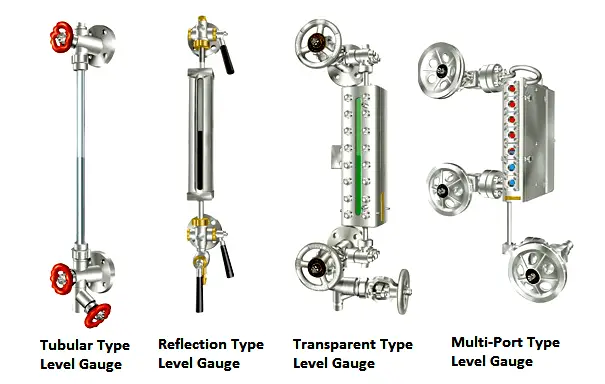
Level gauge consists of a metal body, machined to have an internal chamber and one or more front windows. On each window a special high resistance glass is used with sealing joint and metal cover plate hold by bolts and nuts.
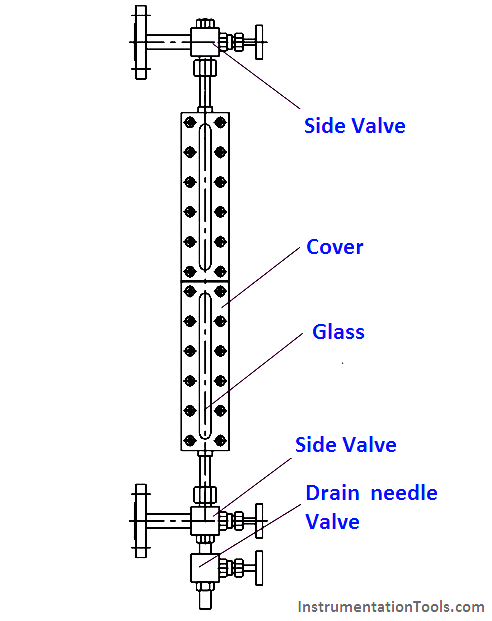
Level devices operate under three main different principles:
- The position (height) of the liquid surface
- The pressure head
- The weight of the material
Types of Level Gauge:
There are commonly 3 types of level gauges used:
- Reflex level gauge
- Transparent level gauge
- Magnetic type level gauge
Reflex level gauge:
Reflex glass level gauges working principle is based on the light refraction and reflection laws.
Reflex glass level gauges use glasses having the face fitted towards the chamber shaped to have prismatic grooves with section angle of 90°. When in operation, the chamber is filled with liquid in the lower part and gases or vapors in the upper part.
The liquid level is well-known by different brightness of the glass in the liquid and in the gas/vapor zone. The reflex level gauges do not need a specific illumination. The day light is enough for seeing the level.
LIQUID ZONE :
This zone appears dark when the gauge is in operation the light ray’s incident on the external face of the glass are quite perpendicular to said face and, therefore, not deviated by the glass. These rays reach the glass/liquid interface with an inclination of approx. 45°. The critical angle glass/liquid is always superior to 45°.
Therefore the rays incident within the critical angle are refracted within the liquid and, since the internal walls of the gauge chamber are not reflecting, the rays cannot be seen from the outside. In fact the zone will appear dark, nearly black, to the observer.
GAS/VAPOR ZONE :
This zone appears silver bright to the observer. As for the liquid zone, the light rays reach the glass/gas-vapor interface with an angle around 45°.
Since this angle is greater than glass/gas-vapor critical angle, the rays are not refracted, but totally reflected making 90° turn, thus reaching the nearest glass/gas-vapor interface again with angle of 45°. For same reason they will be reflected and turned by 90° towards the observer, to whom the zone will appear silver bright.
Applications :
Reflex glass level gauges can be used in most of the fluids and applications.
Reflex level gauges cannot be used in certain cases as for example:
- when the separation level between two liquids has to be read (interface)
- when the process fluid is high-pressure water steam, since in this case the glass must be protected from the solvent action of the boiler water by using mica shields
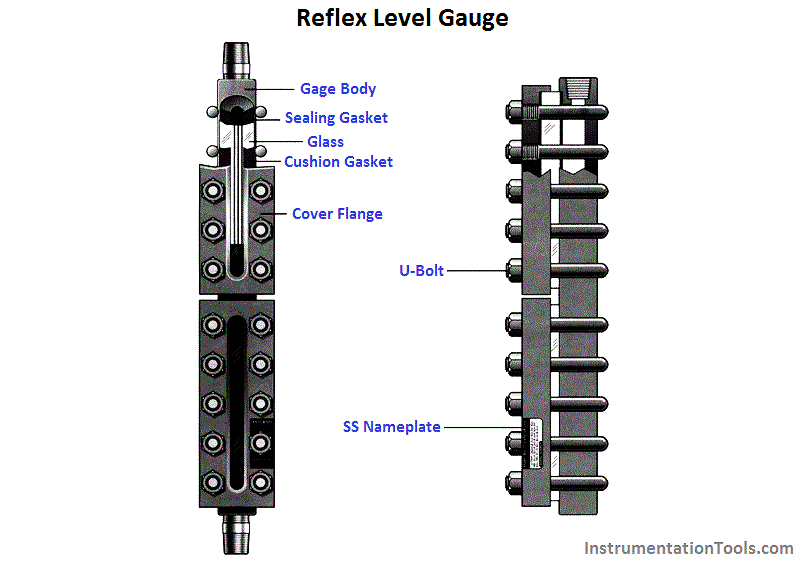
Transparent Level Gauge:
Transparent level gauges are always fitted with two plate transparent glasses between which the fluid is contained. The fluid level is indicated as the result of the different transparency of the two media.
To protect glass surfaces from corrosive action of the process fluid, Transparent Level Gauges can be fitted with Mica shields. The transparent level gauge is particularly recommended for applications where the glass needs to be protected from corrosive fluids and high temperatures.
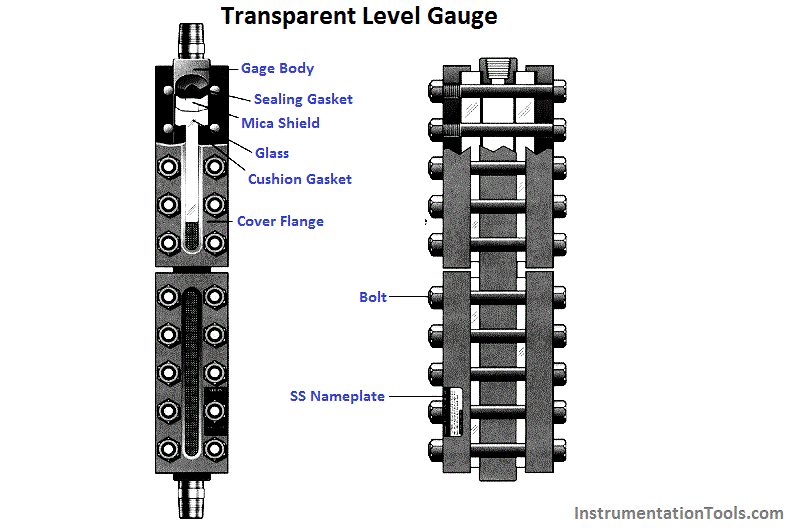
Applications:
- In corrosive fluid.
- The observation of interface
- the observation of the liquid color
- for steam with an operating pressure > 20 bar
- If repeated thermal shocks comes
Mica Sheet use in transparent level gauge: Mica sheet are widely used in visual liquid level to protect the glass surface from the corrosive effects of hot alkaline or acidic solutions. Mica shields are also commonly used in steam water applications to prevent etching and the weakening of the glass
Magnetic Level Gauge:
The Magnetic Level Gauge is used to preventive security against leakage, environmental safety, sure and trouble free application with chemically aggressive, pollutant, harmful or poisonous, inflammable or explosive, optically similar fluid interface.
The magnetic level gauge works based on some elementary physical principles:
- The principle whereby the liquid in communicating vessels is always at the same level
- Archimedes’s principle according to which a body immersed in a liquid receives a buoyancy equal to the weight of displaced liquid
- The principle of attraction between North and South poles of two permanent magnets and that of repulsion between like poles.
There is a float in a pipe chamber which is movement with level and up and down accordingly. A flag flower is clamped with chamber. The individual flags or the follower contain an alignment magnet that couples with the float magnets as the float moves up or down within the piping column.
Float movement rotates the flags and changes their color, the position of the follower, or point at which the flags change color, represents the true level.
According to the orientation of each magnet each cylinder will show externally half of its surface of one colour or the other. The indicating scale will be of one colour over the chamber area taken up by gas, or steam phase contrasting with the other colour (e.g. red) over the chamber area taken up by liquid phase.
Also See : Magnetic Level Gauge Animation
Applications :
- Chemically aggressive fluid
- Pollutant to environment
- Inflammable or explosive fluid
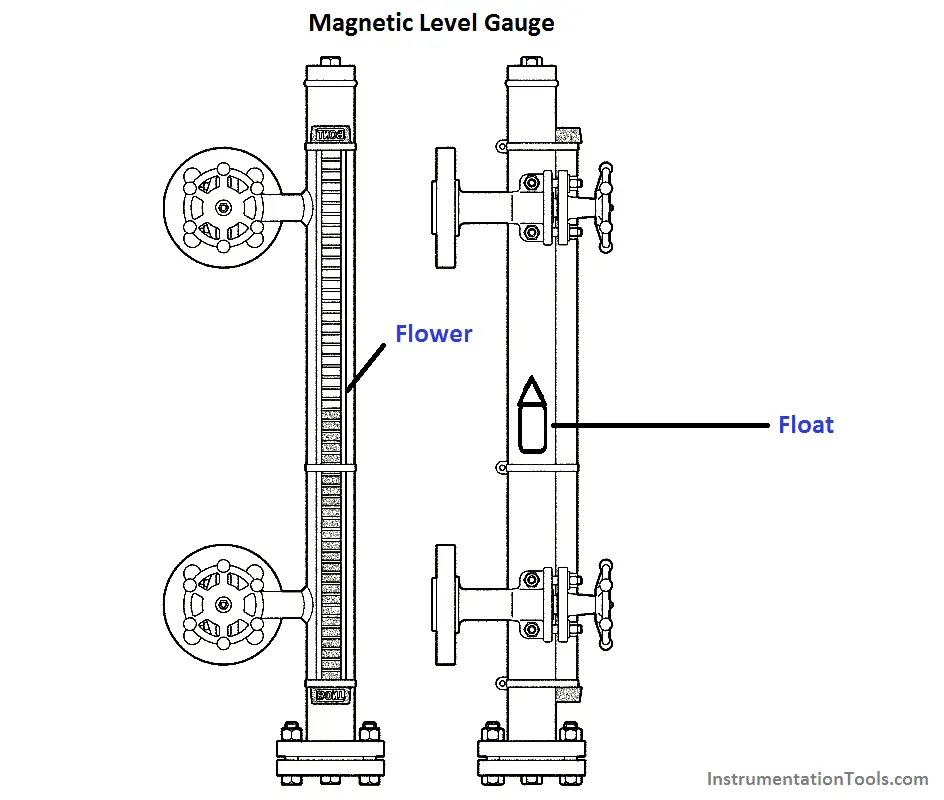
Mica Sheet use in transparent level gauge: Mica sheet are widely used in visual liquid level to protect the glass surface from the corrosive effects of hot alkaline or acidic solutions. Mica shields are also commonly used in steam water applications to prevent etching and the weakening of the glass.
How to change a level glass of a Level gauge :
Following steps to be taken to change the glass:
- Isolate the level gauge from process from HP and LV valve.
- Drain the level gauge process fluid from drain isolation valve.
- Insure no leakage occurred from HP and LP valves.
- Remove the all U-Clamp bolt and removed the glass and gasket and make smooth the surface of chamber and cover flange surface.
- Fix the sealing gasket after some grease applied on chamber window surface. By applying the grease it is easy net time to remove the gasket on next time.
- Fix the mica sheet in case of transparent glass.
- Fix the glass then fix cover flange and cushion gasket then fix the U-Clamp and bolt .
- Tighten the bolt in cross direction. Never tighten the bolt in one direction if tight the glass one direction then possibility to break the glass.
- Tighten the all U-clamp bolt equally.
How to taken in line of level gauge in steam service:
To take the level gauge in line first open the LP valve slightly ½ or 1 turn and heat the glass with continuous draining the steam for some time.
It is necessary because if we taken level gauge directly then a temperature difference occurred and glass may be break and incident may occur.
After this isolate the drain valve then open the HP and LP valve and taken the level gauge in line and checked the leakage.
One point always remember that process person think that slide valve work as a normally isolation valve but this is not an isolation valve. Always kept slide valve in middle.
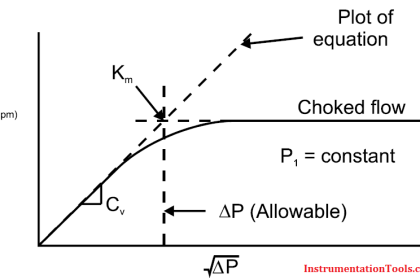

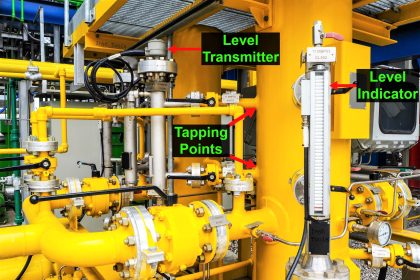
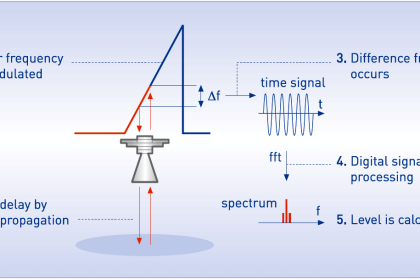

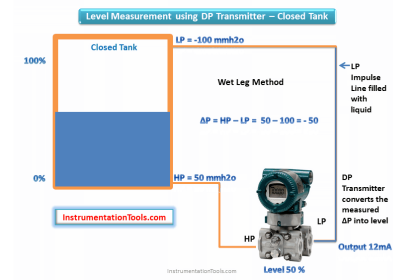
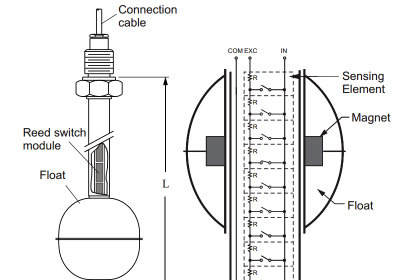
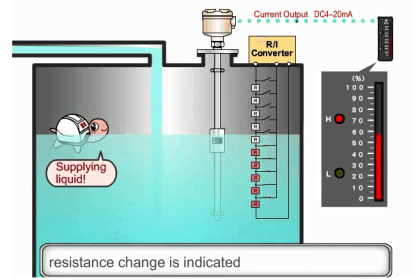
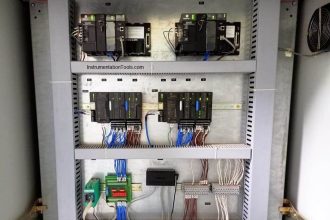

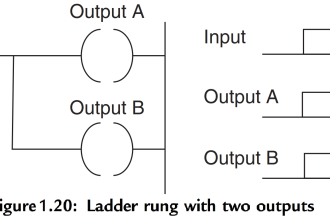


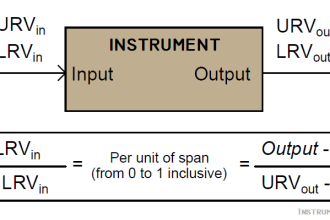



Educative.
Love your article. Please keep uploading more. I hope to become an instrumentation engineer one day. I love your knowledge.
Thanks.